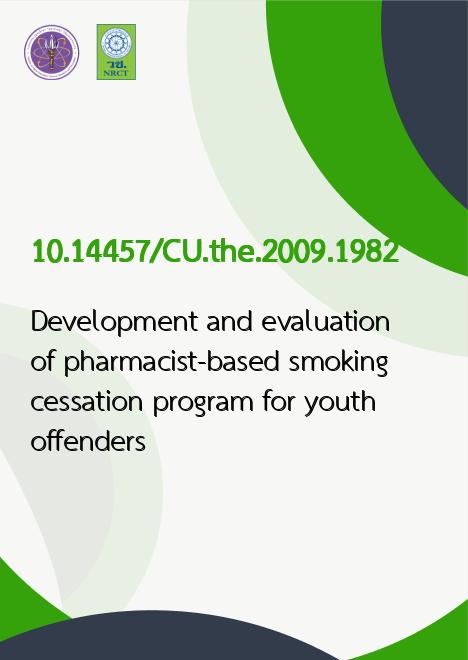
|
Development and evaluation of pharmacist-based smoking cessation program for youth offenders |
|---|---|
| รหัสดีโอไอ | |
| Title | Development and evaluation of pharmacist-based smoking cessation program for youth offenders |
| Creator | Supakit Dumrongpiwat |
| Contributor | Sarinee Krittiyanunt, Supakit Wongwiwatthananukit |
| Publisher | Chulalongkorn University |
| Publication Year | 2552 |
| Keyword | Smoking cessation, Juvenile delinquents |
| Abstract | Background: Current smoking cessation program for youths has been limited, especially in youth offenders whose smoking behavior was quite high. Objectives: To evaluate the effectiveness of a pharmacist-based smoking cessation program for youth offenders between compulsory and voluntary methods in terms of: (1) abstinence rate, (2) health related quality of life, and (3) general knowledge of cigarette smoking. In addition, this study was designed to determine the factors associated with the number of cigarettes smoked per day in youth offenders and to analyse the costs of a pharmacist-based smoking cessation program. Methods: A quasi-experimental, nonequivalent pretest-posttest control group trial was conducted from January 1, 2008 to March 15, 2009 at the Juvenile and Family Section, Pathumtani Provincial Court and Thanyarak Institute. One hundred and eighty two youth offenders were purposely assigned into compulsory and voluntary methods by judge’s discretion. All of them attended the pharmacist-based smoking cessation program at Thanyarak institute for 7 times after the quit date (weeks 0, 2, 4, 8, 12, 16, and 24). The primary outcomes were self-report of continuous abstinence rate and the 7-day point prevalence abstinence rate, evaluated from self report of smoking cessation and urine cotinine test. Data were analyzed using intention to treat analysis, chi-square test, t-test, ANOVA, and multiple regression with a significant level of 0.05. Results: Baseline characteristics were not different between compulsory and voluntary methods (p>0.05), except the stages of change in Transtheoretical Model. Youth offenders in compulsory group had the stage of change in precontemplation 32.2%, whereas none of the voluntary group were in precontemplation stage. Seven-day point prevalence abstinence rate at week 24 of follow up in compulsory and voluntary methods were 35.6% and 15.2%, respectively (p=0.002). However, continuous abstinence rates were not significantly different between 2 methods in every follow-up (p>0.05). A mean number of cigarettes smoked per week in compulsory group was significantly lower than the voluntary group in every follow-up (p<0.001). Total scores of quality of life and general knowledge of cigarette smoking in all follow-ups were higher than baseline but not significantly different between 2 groups. Multiple regression revealed that number of smokers in friends’ group, age started smoking, and educational level at senior high school had moderate association with number of cigarettes smoked per day (R2=0.24). The mean costs of a pharmacist-based smoking cessation program/person/visit were between 24.74-105.04 baht. Conclusions: Seven-day point prevalence abstinence rate in compulsory method was significantly higher than voluntary method. It showed that compulsory method in pharmacist based smoking cessation program may influence youth offenders who were not ready to quit, to change the readiness to quit from precontemplation and contemplation stages to preparation and action stages. |
| URL Website | cuir.car.chula.ac.th |